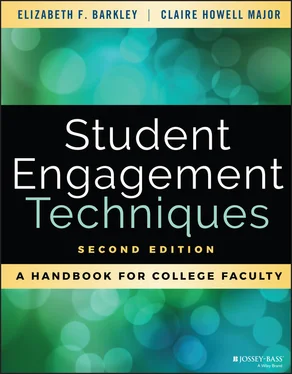Tips and Strategies
Chapter 5: Tips and Strategies for Fostering Motivation
1 1. Expect engagement
2 2. Develop and display the qualities of engaging teachers
3 3. Reward learning rather than behavior
4 4. Use praise and criticism effectively
5 5. Attend to students' basic needs so that they can focus on the higher level needs required for learning
6 6. Promote student autonomy
7 7. Teach things worth learning
8 8. Integrate goals, activities, and assessment
9 9. Craft engaging learning tasks
10 10. Incorporate competition appropriately
11 11. Expect students to succeed
12 12. Help students expect to succeed
13 13. Try to rebuild the confidence of discouraged and disengaged students
Chapter 6: Tips and Strategies for Promoting Active Learning
1 14. Be clear on your learning goals
2 15. Clarify your role
3 16. Orient students to their new roles
4 17. Help students develop learning strategies
5 18. Activate prior learning
6 19. Teach in ways that promote effective transfer of learning
7 20. Teach for retention
8 21. Limit and chunk information
9 22. Provide opportunities for guided practice and rehearsal
10 23. Organize lectures in ways that promote active learning
11 24. Use reverse or inverted classroom organization
12 25. Use rubrics to give learners frequent and useful feedback
Chapter 7: Tips and Strategies for Building Community
1 26. Move away from an authoritarian role
2 27. Promote class civility
3 28. Create a physical or online course environment that supports community
4 29. Reduce anonymity: Learn students' names and help students learn each other's names
5 30. Use icebreakers to warm-up the class
6 31. Use technology to extend or reinforce community
7 32. Be consciously inclusive
8 33. Subdivide large classes into smaller groupings
9 34. Involve all students in discussion
10 35. Use group work effectively
11 36. Use intermissions
12 37. Celebrate community
Chapter 8: Tips and Strategies to Help Ensure Students Are Appropriately Challenged
1 38. Assess students' starting points
2 39. Monitor class pacing
3 40. Help students learn to self-assess
4 41. Differentiate course elements to meet individual student needs
5 42. Use scaffolding to provide assistance for complex learning
Chapter 9: Tips and Strategies to Promote Holistic Learning
1 43. Pick up the pace to hold attention
2 44. Offer options for nonlinear learning
3 45. Use principles of universal design
4 46. Incorporate games
5 47. Teach so that students use multiple processing modes
6 48. Incorporate multiple domains when identifying learning goals
7 49. Include learning activities that involve physical movement
8 50. Consider creating a graphic syllabus
Конец ознакомительного фрагмента.
Текст предоставлен ООО «ЛитРес».
Прочитайте эту книгу целиком, на ЛитРес.
Безопасно оплатить книгу можно банковской картой Visa, MasterCard, Maestro, со счета мобильного телефона, с платежного терминала, в салоне МТС или Связной, через PayPal, WebMoney, Яндекс.Деньги, QIWI Кошелек, бонусными картами или другим удобным Вам способом.












